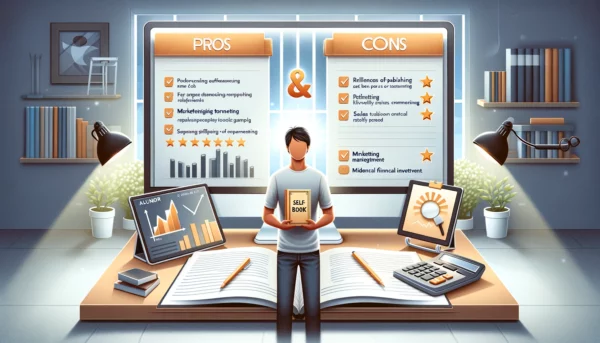Are you tired of waiting for your next great traditional publishing deal, only to be offered peanuts (and not much at that)? You’re not alone. The landscape of book publishing has shifted, and more traditionally published authors are taking the leap to transition from traditional publishing to self-publishing. Why? Because the grass really can be greener on the self-publishing side—if you know how to water it.
Traditional publishing can offer prestige, but it also comes with lengthy timelines, limited control, and the kind of royalties that make you question whether you’re actually a writer or a magician—because your earnings tend to vanish. The journey typically begins with submitting your manuscript to a literary agent. Literary agents play a crucial role in pitching books to editors at publishing houses and managing negotiations, ensuring that your work reaches the right audience.
On the flip side, self-publishing gives you the freedom to call the shots, keep more of your royalties, and engage directly with readers. Sounds like a dream? It could be, as long as you’re ready for the ride. Let’s dive into what it means to make this transition and why self-publishing might just be your next smart move.

Understanding Traditional Publishing
Traditional publishing is a well-established route in the book publishing industry, often seen as the gold standard. The journey typically begins with submitting your manuscript to a literary agent. If the agent sees potential, they pitch your book to a publishing house. This is where the magic—or more often, the waiting game—happens. The publishing house takes over the vast majority of the heavy lifting, handling everything from editing to marketing and distribution.
While this might sound like a dream come true, it comes with its own set of challenges. Traditional publishing often means lower royalty rates and less creative control. The traditional publishing house has the final say on many aspects of your book, from the cover design to the title. However, the trade-off is that you get to benefit from their expertise and resources, which can be invaluable in bringing your book to a wider audience.
Traditional Publishing vs. Self-Publishing: Key Differences
When you think about traditional publishing, you might envision a glamorous book launch, a team of marketing pros, and your book gracing the windows of bookstores worldwide. In reality, you’re more likely to get a polite rejection letter from a literary agent or a contract that takes creative control out of your hands faster than you can say “royalties.”
In traditional publishing, the process often includes getting an agent, signing a contract with a publishing house, and waiting months—if not years—for your book to be released. Publishing houses provide comprehensive support, including editing, marketing, and distribution. You may end up with a team of professionals working on your book, but they’ll also have the final say on things like cover design, pricing, and even the title.
Self-publishing, on the other hand, is like being the captain of your ship—except you get to build the ship too. You decide everything: the timeline, the marketing strategies, and even the book’s appearance. Yes, it’s more work, but when done right, it can also be more rewarding. And the royalties? They’re much better. With platforms like Amazon KDP and Spines, you can publish at your own pace and keep a significantly larger slice of the pie. When considering self-publishing vs traditional publishing, it’s important to weigh the pros and cons of each approach, as there is no one-size-fits-all solution.
Your Publishing Journey Awaits – Start NowTraditional publishers are the gatekeepers of the book publishing world. Traditional publishing houses retain ownership of the rights and make critical decisions regarding the book’s cover, interior design, and marketing strategies. This means that once an author sells their book to a traditional publisher, the publisher retains control over these aspects of the book deal.
The Role of Traditional Publishers
Traditional publishers are the gatekeepers of the book publishing world. They provide a suite of services that can significantly enhance your book’s reach and impact. From meticulous editing to strategic marketing and widespread distribution, traditional publishers have the tools and expertise to make your book a success. They also bring a level of prestige and credibility that can be hard to achieve on your own.
However, getting a foot in the door with a traditional publisher can be a Herculean task. The process is highly competitive and time-consuming, often requiring multiple rounds of submissions and rejections. But for those who make it through, the rewards can be significant. Traditional publishers have a reputation for producing high-quality books, and their endorsement can open doors to opportunities that might otherwise be out of reach.
Making the Decision to Self-Publish: Key Factors to Consider
Before rushing to buy every self-publishing guide you can find (ironically, from a traditionally published author), let’s assess if self-publishing is right for you. Consider your goals: do you want complete control over your book’s destiny? Are you ready to market, write, and promote your work? Self-publishing requires you to wear many hats—editor, designer, marketer—and while that may sound like an exciting entrepreneurial challenge, it’s not for everyone.
Authors of self-published work often face challenges when trying to secure traditional publishing deals, as strong sales are crucial for gaining interest from traditional publishers. These publishers often perceive that the market for such works has already been served, adding to the competition and variability in quality within the self-publishing landscape.
Also, think about your platform. If you already have a built-in audience from your traditionally published works, leveraging that for your self-published ventures could be a smart move. However, if you’re starting from scratch, you’ll need to build your readership, which could take time but is entirely doable with the right strategy.
Evaluating Your Book’s Potential
Before you decide to pursue traditional publishing, it’s crucial to evaluate your book’s potential. Here are some questions to consider:
- Is my book a niche passion project, or does it have broad, national appeal?
- How much control do I want over the publishing process?
- How much does the validation of traditional publishing matter to me?
- How important is it for my book to be in bookstores and libraries?
- How capable am I of marketing and self-promotion?
- Can I afford to invest money in my book?
Answering these questions will help you determine whether traditional publishing is the right path for your book. If your book has broad appeal and you value the prestige of traditional publishing, it might be worth considering. However, if you crave creative control and are willing to invest in your success, self-publishing could be a better fit.
Steps to Transition from Traditional Publishing to Self-Publishing
So, you’ve decided to take the plunge. Here’s how to do it without getting swallowed by the waves:
- Reclaim Your Rights: If you’re still under contract with a traditional publisher, check if you can regain the rights to your book. You don’t want to accidentally end up self-publishing something that your publisher technically still owns.
- Assemble Your Team: While self-publishing means you’re in charge, it doesn’t mean you have to do everything alone. Hire a professional editor, a cover designer, and someone to handle interior formatting. Trust me, Microsoft Word’s default formatting won’t be sufficient.
- Choose Your Platforms: Amazon KDP and IngramSpark are popular choices for distributing your book globally. Each platform has its strengths, so decide whether you want to focus on digital, print, or both.
- Market Like a Pro: Self-publishing means you’ll need to manage your marketing. Start building buzz before your book is even published. Consider creating a website, engaging with readers on social media, and maybe even running ads to drive sales. Effective book marketing is crucial, and assembling a team to handle various aspects of book promotion can significantly boost your success.
By following these steps, you can smoothly transition into the self-publishing world without missing a beat—and maybe even gain a new sense of freedom in the publication process itself.
Exploring Self-Publishing Options
Self-publishing offers a world of possibilities for authors who want to take the reins of their publishing journey. By self-publishing, you retain all rights and responsibilities, giving you complete creative control. This means you can decide everything from the cover design to the pricing strategy. Plus, the royalties are significantly higher, often ranging from 35% to 70%.
However, self-publishing is not without its challenges. It requires a substantial financial investment upfront, as you’ll need to hire professionals for editing, cover design, and formatting. Marketing is also entirely on your shoulders, which means you’ll need to be proactive and strategic to get your book noticed. But for those who are willing to put in the work, self-publishing can be incredibly rewarding, offering faster time-to-market and the satisfaction of seeing your vision come to life.
Hybrid Publishing: A Middle Ground
If you’re torn between the benefits of traditional publishing and the control of self-publishing, hybrid publishing might be the perfect solution. Hybrid publishers offer a blend of services from both worlds. They provide professional editing, cover design, and marketing support, but instead of offering an advance, they may ask you to invest upfront to cover these costs.
Your Publishing Journey Awaits – Start NowHybrid publishing allows you to maintain some control over the publishing process while still benefiting from professional services. It’s a great option for authors who need help with certain aspects of publishing but want to avoid the lengthy timelines and lower royalties of traditional publishing. By choosing hybrid publishing, you can enjoy the best of both worlds, making it a viable middle ground for many authors.
The Benefits of Self-Publishing: What You Gain from Going Independent
Picture this: you wake up one morning, check your book sales, and realize you’re actually making money. Sounds good, right? That’s one of the biggest perks of self-publishing—you keep more of what you earn. With traditionally published books, authors might only take home a small percentage of their book’s revenue, while self-published authors can earn anywhere from 35% to 70% in royalties. That’s real money, not just enough for a celebratory coffee. The rising popularity and financial potential of self-published books are evident, with significant statistics showing that this market is growing rapidly compared to traditional publishing.
In addition to better royalties, you also gain total creative control. Want your book cover to feature a flying dragon wearing sunglasses? No problem. Want to price your book at $2.99 for a quick sales boost? You’re the boss. With self-publishing, you can experiment with different selling strategies and make adjustments as you go.
Challenges of Self-Publishing: What to Be Prepared For
As great as self-publishing sounds, it’s not all sunshine and royalty checks. One of the biggest challenges is that everything—from editing book design to marketing—is on your plate. You’ll need to make sure your book is professionally edited, well-designed, and formatted correctly for both print and digital versions. This can cost anywhere from a few hundred to a few thousand dollars upfront.
On the other hand, to traditionally publish, authors face significant barriers to entry, such as securing a literary agent and getting a publishing deal, which can be highly competitive and time-consuming. And don’t forget the marketing. In traditional publishing, you might have reputable agents and a sales team doing the heavy lifting for you, but in self-publishing, you’re the sales team. It can be tough to break through the noise, especially in a saturated market, but with the right strategy, it’s possible.
Building Your Author Brand in the Self-Publishing World
Branding isn’t just for businesses—authors need it too. If you’re self-publishing, creating an author brand is essential to your success. Start by building a website where readers can learn more about you and your books. Add a blog, collect emails for a newsletter, and engage with your audience on social media platforms like Instagram, Facebook, or Twitter.
Your brand should reflect your unique identity as an author. Are you the witty mystery writer with a knack for suspense? Or maybe you’re the romance author who loves a good twist? Whatever your writing style, make sure your branding is consistent across your website, book covers, and online presence.
Marketing Your Self-Published Book: Essential Strategies for Success
Marketing is the secret sauce that can turn your self-published book into a bestseller—or at least get it noticed. Proactive and strategic marketing efforts are essential for self-published work to stand out in the crowded market. Start by nailing your cover design. As they say, people do judge a book by its cover, so make sure yours is professionally done and fits your genre.
Next, build buzz before your launch. Use social media, email lists, and even book giveaways to get readers excited. Post-launch, don’t be afraid to run ads on platforms like Facebook and Amazon to keep the momentum going. Reviews are crucial too—reach out to bloggers, fellow authors, and influencers in your genre to get some honest reviews for your book.
Final Thoughts: Embracing the Freedom of Self-Publishing
Self-publishing isn’t just a backup plan; for many authors, it’s the better plan. The freedom, control, and potential for higher earnings make it an attractive option for writers ready to take charge of their careers. Yes, it comes with challenges, but the rewards are well worth it. So, if you’re ready to make the leap, dive in—you might just find the creative and financial freedom you’ve been looking for.
Ready to take control of your publishing future? At Spines, we’re here to help you transition smoothly from traditional publishing to self-publishing. With our all-in-one platform, you can publish your book faster, smarter, and on your terms. Get started today and see how easy it can be to bring your book to life—just one click away from making it happen. Schedule a 15-minute Free Consultation call.
Your Publishing Journey Awaits – Start Now







